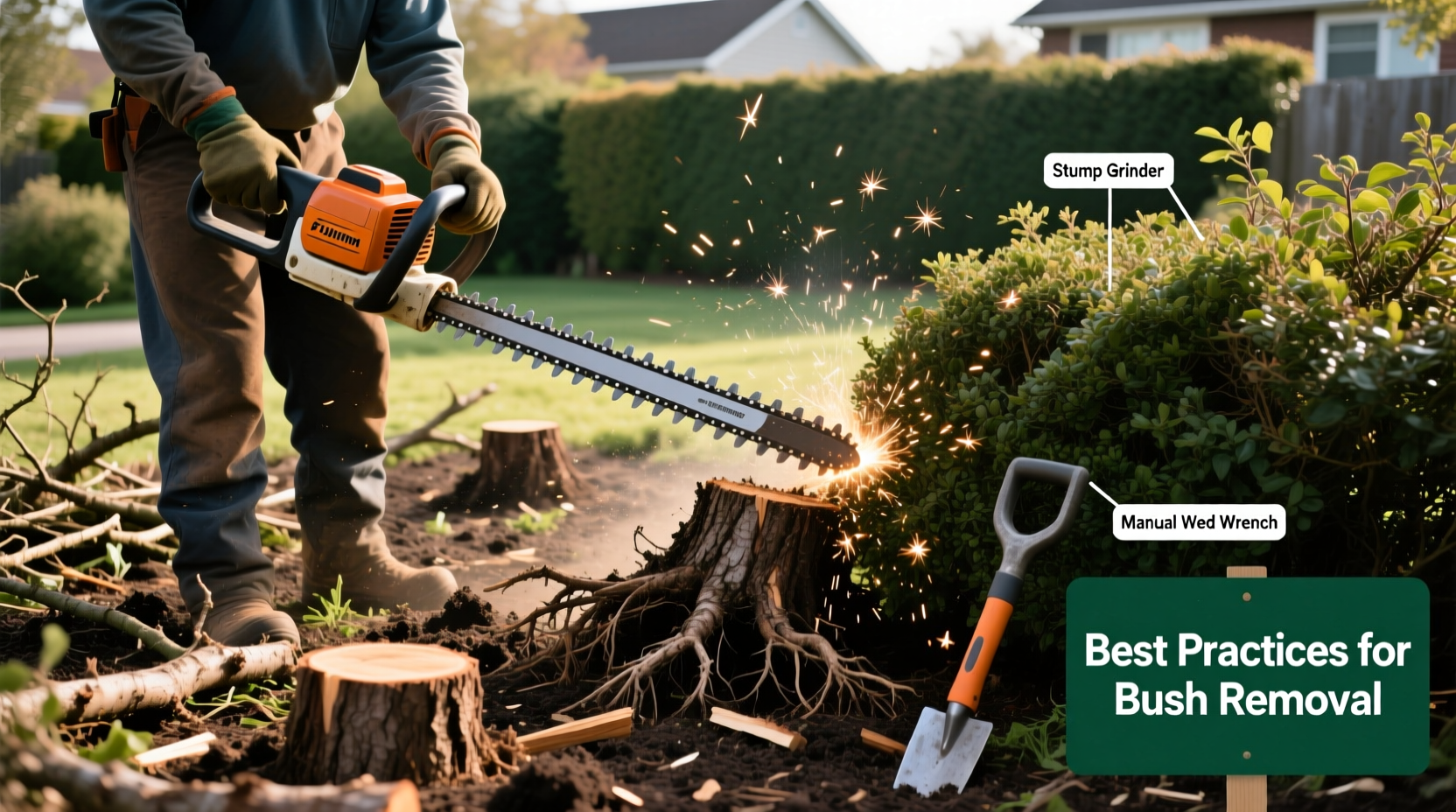Removing unwanted bushes is a common landscaping challenge. Whether they’re invasive, obstructing construction, or simply growing where they don’t belong, persistent shrubs can be tough to eliminate. Chemical herbicides are often the first thought, but there are multiple proven techniques—chemical, mechanical, and organic—that deliver long-term results. The key lies in understanding the root system, timing your approach correctly, and choosing the method that aligns with your environmental values and project scale.
Understanding Bush Growth and Root Systems

Before attempting removal, it’s essential to understand what makes bushes so resilient. Most woody shrubs develop extensive root systems capable of storing energy and sending up new shoots even after the visible plant is cut down. Species like multiflora rose, honeysuckle, and sumac are notorious for regrowing from root fragments left in the soil.
Successful bush eradication hinges on targeting both the above-ground biomass and the underground network. Simply cutting a bush down without treating the stump or roots often leads to vigorous re-sprouting within weeks. For permanent control, you must interrupt the plant’s ability to photosynthesize and deplete its stored energy reserves.
“Cutting a bush without addressing the root system is like mowing the lawn—you’ll be back doing it again soon.” — Dr. Alan Reyes, Urban Forestry Specialist, University of Vermont Extension
Mechanical Removal: Cutting and Digging
Physical removal is one of the most straightforward approaches, especially for smaller bushes or isolated specimens. This method involves cutting the plant at ground level and excavating as much of the root ball as possible.
Tools required include loppers, a pruning saw, a shovel, and optionally a mattock or grub hoe for stubborn roots. Begin by trimming branches to reduce bulk, then cut the main stem close to the ground. Use the shovel to dig around the base, exposing and lifting out the primary root mass.
This method is chemical-free and ideal for organic gardens or areas near water sources. However, it becomes impractical for large, mature bushes or dense thickets due to labor intensity. Even with careful digging, small root fragments may remain and regenerate.
Step-by-Step Guide to Mechanical Bush Removal
- Trim back foliage to access the base of the bush.
- Cut the main trunk as close to the ground as possible.
- Dig a trench around the base (at least 12 inches from the stem).
- Loosen soil and undercut the root ball.
- Lift the root mass and inspect for remaining fragments.
- Remove all visible roots and monitor the area for new sprouts.
Chemical Methods: Herbicides for Permanent Control
For larger infestations or deep-rooted species, targeted herbicide use offers a reliable solution. The most effective strategy combines cutting with immediate application of a systemic herbicide to the fresh stump surface.
Systemic herbicides like glyphosate or triclopyr are absorbed into the vascular system and transported to the roots, killing the entire plant over 7–14 days. Timing matters: apply immediately after cutting while the cambium layer is still active and able to absorb the chemical.
| Herbicide Type | Best For | Application Method | Time to Effect |
|---|---|---|---|
| Glyphosate | Broadleaf and grassy species | Stump treatment or foliar spray | 7–14 days |
| Triclopyr | Woody shrubs and brush | Basal bark or cut-stump | 10–21 days |
| Imazapyr | Dense stands and resprouters | Foliar or soil application | 2–4 weeks |
Avoid spraying herbicides on windy days or near desirable plants. Always follow label instructions and wear protective gear. While effective, chemical options should be used judiciously, especially near groundwater or edible landscapes.
Organic and Natural Alternatives
For those avoiding synthetic chemicals, several natural methods can weaken and eventually kill bushes—though they require more time and repetition.
- Vinegar Solution: A mixture of 1 gallon of 20% acetic acid vinegar, 1 cup of salt, and 1 tablespoon of dish soap can burn foliage. Effective on young growth but rarely kills roots.
- Smothering: Cover the bush and surrounding soil with thick layers of cardboard or black plastic, weighted down with mulch or stones. This blocks sunlight and depletes energy stores over 3–6 months.
- Repeated Cutting: Mow or shear new sprouts weekly throughout the growing season. This exhausts root reserves over time, typically requiring one to two full seasons.
Mini Case Study: Eliminating Invasive Honeysuckle in Ohio
A homeowner in central Ohio struggled with a 15-foot-wide patch of Amur honeysuckle, an aggressive invasive species. Initial attempts to pull saplings failed as mature roots sent up dozens of new shoots. The property owner adopted a phased approach: in late summer, they cut all stems to 6 inches and applied a 20% triclopyr solution to each stump. They followed up in spring by removing any survivors and laying cardboard topped with wood chips over the area. After one year, regrowth was reduced by over 90%, and native plants were reintroduced successfully.
Preventing Regrowth and Site Restoration
Killing a bush is only half the battle. Preventing regrowth requires vigilance and site management. Monitor the area monthly during the growing season and treat or remove any new sprouts immediately before they establish energy reserves.
Once the bush is gone, restore the area with competitive vegetation. Planting native ground covers or grasses helps occupy the space and reduces the chance of weeds or resprouting invasives.
📋 Checklist: Post-Removal Best Practices- Inspect the site every 2–3 weeks for new growth.
- Remove sprouts by hand or spot-treat with herbicide.
- Replant with desirable species to stabilize soil.
- Apply mulch to suppress weed emergence.
- Document progress with photos to track effectiveness.
FAQ
Can I kill a bush by just cutting it down?
No. Most woody shrubs will resprout vigorously from the stump or roots if not treated. Cutting alone is ineffective for permanent removal.
What’s the best time of year to kill bushes?
Late summer to early fall is ideal. Plants are moving nutrients to their roots, making herbicide applications more effective. Spring is second-best for mechanical removal before leaf-out.
Are there eco-friendly ways to kill bushes?
Yes. Smothering with cardboard and mulch, repeated cutting, and using high-concentration vinegar solutions are non-chemical options. They take longer but avoid synthetic inputs.
Conclusion
Eliminating unwanted bushes demands more than brute force—it requires strategy, patience, and the right tools for the job. Whether you choose mechanical excavation, targeted herbicides, or organic suppression, success depends on attacking the root system and preventing recovery. The most effective outcomes come from combining methods: cut, treat, monitor, and replace. With consistent effort, even the most stubborn shrubs can be removed for good, opening space for healthier, intentional landscaping.









 浙公网安备
33010002000092号
浙公网安备
33010002000092号 浙B2-20120091-4
浙B2-20120091-4
Comments
No comments yet. Why don't you start the discussion?